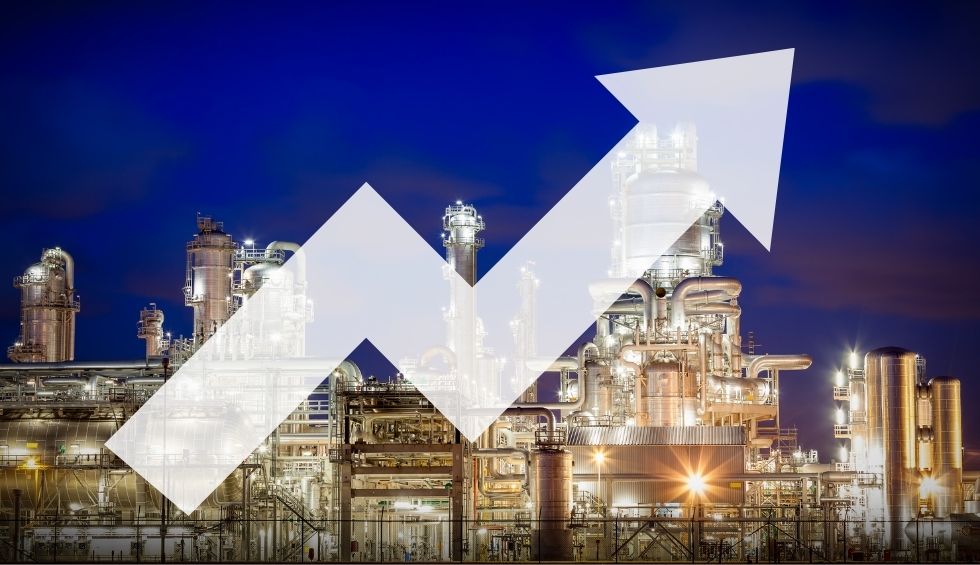Global investment into energy, infrastructure, mining, and real-estate-related projects is accelerating- in fact McKinsey research expects that by 2030 investment could increase to $13 trillion. What trends to we see shaping the project business industry? What benefits and challenges will these emerging trends present for project managers? Here is what you can expect in project business in Europe during Q2 of 2022.
1) Further adaptation of AI and automation tools
We’re expecting to see the role of AI increase in data management, interpretation and visualization. Large and complex project sites today can have thousands of data points, such as smart (IoT) devices, industrial equipment, RFID-tags, QR-codes, images, sensors and smart readers. Processing these volumes and speeds of new data using traditional methods is simply not efficient. Without the use of AI and automation tools, project managers could be stuck with vast amounts data without context. We believe AI and automation tools are key to helping project managers make smarter decisions faster.
2) Increased project costs
Soaring gas, oil and electricity costs are adding to pressures on energy intensive construction projects. Prices are also at an all-time high for materials such as cement, timber and steel, with many manufacturers introducing price increases of 5-10%. Many energy-intensive products have seen price increases of even 20%. The price increase is caused by a combination of production issues from the pandemic, a strong demand, port blockages and high logistics cost.
We’re expecting to see increasing amounts of projects running over budget. Additionally, project costs and feasibility studies will be even more complex to execute in project business in Europe.
3) Interest in energy projects in Europe
Currently, the EU imports 90% of its gas consumption. Russia provides around 45% of gas imports, 25% of oil imports and 45% of coal imports into Europe. On 8th March 2022 The European Commission proposed an outline of a plan to make Europe independent from Russian fossil fuels well before 2030. The outline starts with gas with the goal of diversifying gas supplies and speeding up the roll-out of renewable gases. We predict an increased demand in new gas and energy projects in the EU and it’s member states as a result of this proposal.
4) Less software platforms – skyrocketing efficiency
You might be shocked with this one, considering that research shows that 77 percent of successful projects use project management software.
One of the biggest challenges in global investment projects today is the lack of information continuity. Different project functions, such as engineering, cost forecasting and scheduling have typically been managed in their own tools, completely disconnected from the other functions. This has lead to project functions being managed in independent silos where project processes are not aligned and information is not shared efficiently across teams.
From our conversations with project managers across pulp & paper, oil & gas and energy investment projects, we identify the same trend- project managers want to manage as much information as possible on one platform. There is also an increasing demand for open interfaces, integrations and automatic data transfer across existing tools.
So what we really mean with less software platforms is that project managers are looking to integrate their existing software solutions and when purchasing new software for the project, they are looking for scalable solutions to support multiple project functions. Overall, we predict that the use project management software will increase but the amount of software bought for individual project functions will decrease.
5) Heightened focus on environmental factors
New investment projects will need to be planned and executed with stricter environmental policies and goals in mind. The EU is aiming to become climate-neutral by 2050 with net-zero greenhouse gas emissions. Businesses are expected to have to spend increasing amounts of their revenues on capital expenses as they modernize outdated plants and build new ones that meet intensifying sustainability requirements. While many sustainability requirements are mandated by law, a lot of organizations are seeking to meet even stricter sustainability goals set by themselves.
While coming up with innovative technologies and processes to support the net-zero greenhouse gas emissions might present challenges for organizations, there are also many opportunities. For example, there are immense opportunities for clean energy production and development of new technologies – all with the support of the EU.
You might also enjoy this article on material efficiency in capital projects.
6) Continued materials shortages
Construction projects are facing unprecedented shortages of steel, bricks, cement and timber. Large megaprojects, such as underwater tunnels, require millions of cubic yards of concrete and any supply shortage or change in price to concrete can have a detrimental effect on the project.
The root causes of material shortages include:
- Increased renovation activity during 2020 during the initial lock-down (increased demand).
- Slowdown in production of materials during the pandemic. Supply chains and warehouse inventories have remained streched ever since and manufacturers and suppliers are struggling to build up stock levels.
- Increasing energy, transport and raw material costs combined with increasing inflation are providing challenges for many suppliers and contractors.
We don’t expect the supply chain struggles to ease with the ongoing crisis in Ukraine. Many materials used in investment projects come from Ukraine.
7) Logistical challenges to be expected
Airspace restrictions over Europe and Russia will present major logistical challenges for the air cargo sector. For example, longer routes will have to be taken to avoid airspace around Russia, which has been the optimal flying route between Asia and Europe with the shortest flying time and lowest fuel consumption. The conflict has also caused increases in the prices of fuel, which make up at least a quarter of airlines’ cost base. For example, Finnair has stopped cargo and passenger flights to Asia completely, stating that alternative routes aren’t competitive or economically sustainable. Cargo capacity has also decreased, which is adding up tensions to supply chains still struggling from pandemic-related cutbacks.
Ultimately we will see an increase in the price of air-cargo, with some industry experts suggesting price increases of 30%-50%. This will most likely result in increased demand for sea-cargo, which drive up the prices for all logistics in the long run.
8) Instability in the business environment
The European stock market – and the marketplace in general- is in a state of shock as a result of the crisis in Ukraine. The stock market in Europe has tumbled and investors are increasingly concerned about the outlook for the region’s bear market- pulling out an unprecedented $6.7bn from European stock funds. Decreased consumer confidence combined with high inflation and increasing energy prices worry investors of a recession.
In addition to the grim economic outlook of the marketplace, uncertainties around logistics and raw material supplies will cause even more unease for the business environment.
These instabilities in the market will make it more difficult to complete feasibility studies and cost budgeting. We’re expecting to see prolonged investment decisions.
What trends do you see shaping the project business in Europe?
There are many more trends shaping project business in Europe, that we haven’t covered in this article, such as increased attention to cyber security and remote work from home practices. The only constant in change- that is very true for project business as well. Project managers can navigate the developing business environment by staying on top of industry trends.
Did you enjoy this article? You might also enjoy our articles on
- Productivity in mega projects
- New trends in material deliveries to capital projects- how are suppliers responding?
- Excels in capital project materials management
- Software in capital projects- how to get supplier buy-in?
Want to discuss project business in Europe further? Get in touch!

Heljä Muinonen
Sales & Marketing (Valpas & MHS)
email: helja.muinonen@loginets.com
phone: +358 40 934 5189
Sources:
https://ec.europa.eu/commission/presscorner/detail/en/ip_22_1511
https://www.ft.com/content/2dbbd373-8764-4e59-bf1f-7fa385846847
https://www.ft.com/content/73b3f45e-b096-436c-b6d0-3402a1e2b053
https://www.homebuilding.co.uk/news/construction-materials-shortage
https://www.freightwaves.com/news/ukraine-crisis-creates-logistics-headaches-for-air-cargo-airlines
https://ec.europa.eu/clima/eu-action/climate-strategies-targets/2050-long-term-strategy_en
https://www.theprojectgroup.com/blog/en/project-management-trends/


